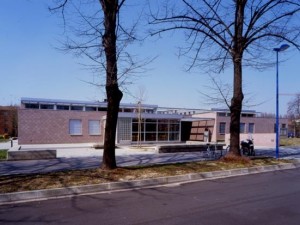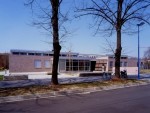G. Bassani Municipal Library
As described on its website, the G. Bassani Municipal Library in Ferrara is a ‘public library with spaces for kids, gatherings and multimedia materials’. Second in Ferrara in terms of number of books borrowed and the cultural heart of the city's northern outskirts, the library was ‘reborn’ in 2002. In that year, the custom-designed branch was opened, part of a larger redevelopment project involving the entire quarter.
The building
Designed in 1998 by Giovanni Fumagalli and Carlo Melograni, the construction of the G. Bassani Municipal Library was part of an innovative redevelopment plan for the northern outskirts of Ferrara. Once called ‘Barco’, this quarter it was developed in the early 1940s by the Independent Council Housing Institute (now the Emilia-Romagna Housing Company) as a neighbourhood for workers. Though Barco was given a municipal library in 1973, it was the urban planning programme in the early 2000s to provide it with a dedicated building for the first time in the quarter's history. During its inauguration on 4 May 2002, the library's name was changed from the Barco Municipal Library to the G. Bassani Municipal Library. Giogrio Bassani, who lived in Ferrara, is remembered in a bronze bust in the patio leading to the building's entry. It was crafted by Mirella Giudetti Giacomelli for the occasion. Standing outside the city walls, 5 km from the old town and 2 km from the River Po, the building has 1,350 m2 of indoor floor space, 1,230 m2 of which are open to the public, plus 350 m2 of outdoor space. Rooms and services dedicated to the public include an auditorium with a 120 person capacity for performances and meetings, a periodicals section, a reading room and loan materials for children, a multimedia room, an exhibition space and various areas in which to read and study. Despite being on the outskirts, the G. Bassani Library is well connected to the city centre via public transport and cycling routes, allowing it to become the heart of northern Ferrara. This attractive cultural centre is quite capable of reversing the flow of residents that, up until it opened, had flocked to the centre of town, attracting many users who had never even been to the Barco quarter before. Within two years of its opening, the G. Bassani Library has become the second most important library in Ferrara, after the prestigious Ariostea Library. This was a crucial factor in the redevelopment of the entire quarter, in the eyes of its residents as well as those living elsewhere in the city and beyond, having an impact that is recognised locally and nationally. If the volume of loans and vivacity of the proposed initiatives, aimed at citizens and schools alike, have had a hand in all this, it cannot be forgotten how much the building has contributed to the library's success. Carefully designed in terms of its shapes, dimensions, materials and uses, the structure is characterized by - and stands out for - its pronounced rationalism and minimalism, balanced by internal spaces on a human scale and the constant blending of interior and exterior, capable of ideally expanding physical boundaries.
Quotes
Bassani himself wrote a few words in reference to the area of Ferrara in which the G. Bassani Library is located, the former Barco quarter: ‘It has always been a particularly lonely place. So it was, thirty years ago, and it still is today, despite the fact that to the right especially, facing the industrial zone, from 1945 on, scores of variously coloured workers’ cottages have sprouted, in comparison with which, and with the factory chimneys and warehouses that compose their background, the brown, scrubby, half-rocky spur of fifteenth-century fortifications looks day by day ever more absurd. (G. Bassani, The Garden of the Finzi-Continis, translated by Jamie McKendrick) On the building of the G. Bassani Municipal Library ‘The new organisation embodies the capacity to welcome initiatives in special contexts and the simultaneous possibility to extend them beyond their physical boundaries, to facilitate actions ‘for and among the people’. Within the building, with well-balanced elements and measured expressive style, it suggests a rethinking of some currents of Modernist architecture, with references both to Italian Rationalism and to Scandinavian experimentalism. … The stated objective...is to define a principle of identity starting from the moral value of architecture. The guidelines of the composition, expressed through primary shapes, rather than a focus on expressionist emotion, are the product of a methodology that aims for minimalism and rejects waste, both in terms of style and materials. What emerges is a philosophy of action that is the offspring of a given political (cultural) vision rather than the internal tension of architecture...’ (M. Locci, ‘Cultura per la Gente e fra la Gente: Biblioteca “Bassani” a Ferrara’, in AR. Bimestrale dell’Ordine degli Architetti di Roma e Provincia, n. 57/05, vol. XL, January-February (2005), pp. 6-7) On the two main library branches of Ferrara: The Municipality of Ferrara named the new library after Giorgio Bassani, honouring the city’s most illustrious twentieth-century writer... After Ariosto, there is thus Bassani, both now inextricably linked to the two most important municipal libraries. On the one hand, there is the Ariostea Library, the city's oldest institution, whose main task is conservation, made prestigious by its monumental setting, history and the wealth of its collections. On the other is the new, modern Bassani Library, an interesting architectural work also, with a different mission, one that is more focused on multimedia communication, of elevating the potential of digital information. Ariosto and Bassani: so Ferrara evolves, changes, and is enriched, becoming a city of literature, of writing and books, and thus, of libraries. The Ariostea Library and the Bassani Library: old and new. Two different examples in terms of time and space, that of history and that of literature; two mirrored faces that can be traced back to synthesis in the public purpose and mission that they, as libraries, share. The first is in the heart of the city, within the walls, in historical Via delle Scienze, in Palazzo Paradiso, an Este delizia, later also a site of the city's university; the second, on the other hand, is outside the walls, in an industrial, working-class neighbourhood. The two are part of a larger vision that, as of today, is clear, precise, more intelligible for the role that is assigned to the first and that which will naturally characterise the second.’ (E. Spinelli, Da Angelica a Micol, ‘IBC’, XI, 2003, 02)
Bibliography
- Bassani, Giorgio, Il giardino dei Finzi Contini, Mondadori, Milano 2001
- Massimo Locci, Cultura per la gente e fra la gente: Biblioteca “Bassani" a Ferrara, in «AR. Bimestrale dell’ordine degli architetti di Roma e provincia», anno XL, n. 57/05, gennaio-febbraio (2005), p. 3ss
- Elena Marchigiani, Passeggiate ferraresi. Un itinerario attraverso la città pubblica, in «Edilizia popolare», anno L, 2003-2004, n. 277/278, p. 4ss
- Giovanni Fumagalli, Carlo Melograni, ACER Ferrara. Quartiere Barco. Un nuovo centro è nato in periferia, in «Edilizia popolare», anno L, 2003-2004, n. 277/278, p. 72ss
- Giacomo Savioli, Dalla Biblioteca Barco alla Biblioteca Bassani: una ignota eredità, in «FD. Bollettino della Ferrariae decus», n. 19, (31 mag. 2003), p. 81s
Sitography
Fototeca
Compiling entity
- Assessorato alla Cultura e al Turismo, Comune di Ferrara
Author
- Barbara Pizzo


